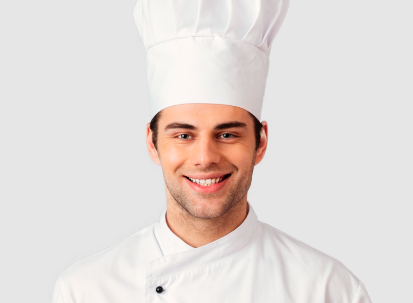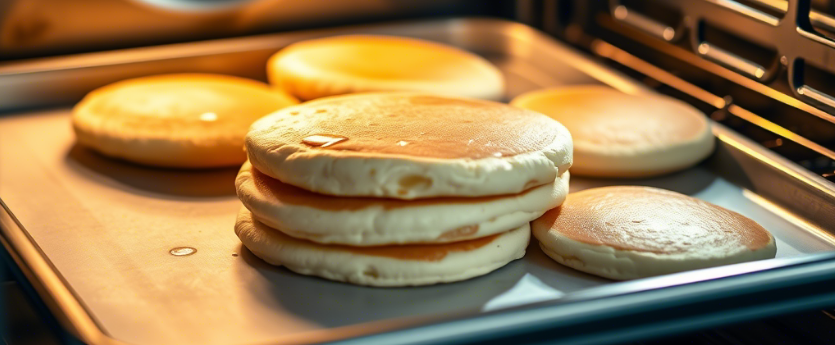
Hi there, I’m Chef Marcus — and let me tell you right away: pancakes are deceptively simple. Anyone can mix flour, milk, and eggs — but perfect pancakes? Golden outside, soft and fluffy inside, evenly cooked with just the right texture? That takes a little know-how.
And the secret weapon most home cooks overlook? Temperature.
I’ve spent years in professional kitchens (and honestly, plenty of weekend mornings at home) testing every way you can possibly cook a pancake. Frying pan, oven, multicooker, even microwave — I’ve tried them all. And believe me, temperature control is all.
In this guide, I’m going to break it all down for you — from the exact temperature settings I use to little chef tricks for each cooking method. Doesn’t matter if you’re after classic pancakes, healthy ones, or trying out a new gadget — we’ll get your pancakes just right.

Best Temperature to Cook Pancakes: Simple Recipes & Tips for Perfect Results Every Time
If you’ve ever struggled with pancakes turning out too pale, burning too fast, or staying raw in the middle – trust me, you’re not alone. Finding the best temperature to cook pancakes really is the secret to those golden, fluffy, restaurant-style results we all love. In this guide, I’ll break down everything I know about the best temperature to cook pancakes, how to adjust it based on your equipment, and share a few of my personal favorite recipes for everyday cooking. Whether you’re using a skillet, oven, air fryer, or even a microwave (yes, it’s possible), this guide has you covered.
What is the Best Temperature to Cook Pancakes?
From my experience, the sweet spot for cooking pancakes on a stovetop is about 175-190°C (350-375°F). That’s the range where the surface caramelizes perfectly without burning, and the inside gets fully cooked before the outside gets too dark. But depending on your stove, pan, and even batter, you might have to adjust slightly.
If your pancakes are getting dark too quickly → lower the heat.
If they stay pale and raw inside → increase the heat slightly or give them more time.
Here’s a quick reference table for different equipment:
| Cooking Method | Optimal Temperature | Cooking Time Per Side |
|---|---|---|
| Skillet or Pan (Stovetop) | 175-190°C | 2-3 minutes |
| Electric Griddle | 175-190°C | 2-3 minutes |
| Oven (Baking) | 180°C (preheated) | 10-15 minutes total |
| Air Fryer | 160-170°C | 6-8 minutes total |
| Microwave | Medium Power | 1-2 minutes total |
Why Temperature Matters So Much
Temperature is everything when cooking pancakes. Too low, and your pancakes come out rubbery and flat. Too high, and you risk burning the surface while leaving the inside undercooked. Also, oil or butter in the pan behaves differently at different temperatures – so mastering this makes your life much easier.
Plus, each cooking tool behaves differently:
- Gas stoves heat fast and unevenly.
- Electric stoves are slower but stable.
- Cast iron pans retain heat but might scorch pancakes fast.
- Non-stick pans are safer but sensitive to high heat.
If in doubt, always do a small test pancake first!
Pancake Recipes for Every Day
Here are some of my go-to recipes – and I’ll explain exactly why I love each of them.

Classic Fluffy American Pancakes
This is the basic pancake I do most often — thick, fluffy, slightly sweet.
| Ingredient | Amount |
|---|---|
| All-purpose flour | 200g |
| Milk | 300ml |
| Egg | 1 large |
| Baking powder | 2 tsp |
| Sugar | 2 tbsp |
| Salt | Pinch |
| Butter (melted) | 2 tbsp |
Why I love it: This is the foolproof base recipe. It works for breakfast, brunch, or even dessert with fruits or chocolate chips. The batter is forgiving, and the pancakes puff up nicely even on medium heat.
→ Cook at 175-185°C for 2-3 minutes per side.
Healthy Oatmeal Banana Pancakes
Perfect for a light, healthy breakfast with natural sweetness.
| Ingredient | Amount |
|---|---|
| Rolled oats (blended) | 100g |
| Ripe banana | 1 large |
| Egg | 1 large |
| Milk or Almond milk | 150ml |
| Baking powder | 1 tsp |
| Salt | Pinch |
Why I love it: No sugar, no flour — just oats and banana. Naturally sweet, filling, and ideal for diet-friendly meals. They cook a little slower, so lower the heat to avoid burning.
→ Cook at 170-180°C for 3-4 minutes per side.
Protein Pancakes (Fitness Style)
For gym lovers who still want pancakes!
| Ingredient | Amount |
|---|---|
| Protein powder (vanilla) | 40g |
| Oat flour | 80g |
| Egg | 1 large |
| Greek yogurt | 100g |
| Milk | 150ml |
| Baking powder | 1 tsp |
Why I love it: Great post-workout food. They tend to dry out if overcooked, so lower heat and watch them carefully.
→ Cook at 170-180°C for 2-3 minutes per side.
Tips for Perfect Pancakes
Achieving pancake perfection involves more than just the right temperature. Here are some additional tips from my kitchen to yours.
Mistakes to Avoid
- Overmixing the Batter: This can lead to tough pancakes. Mix until the ingredients are just combined; lumps are okay.
- Flipping Too Early: Wait until bubbles form and the edges look set before flipping to ensure even cooking.
- Inconsistent Heat: Maintain a steady temperature to avoid uneven cooking and browning.
How to Keep Pancakes Warm
To keep pancakes warm while cooking batches, place them on a baking sheet in a preheated oven at 200°F (95°C). This keeps them warm without overcooking. This is the best temperature co cook pancakes.
Best Oils and Butter to Use
- Butter: Offers rich flavor but can burn at high temperatures. Clarified butter is a better option for higher heat.
- Vegetable Oils: Neutral oils like canola or sunflower have higher smoke points and won’t overpower the pancake’s flavor.
FAQ About Making Perfect Pancakes
What is the best temperature to cook pancakes on a stove or skillet?
I always recommend cooking pancakes on medium to medium-high heat, which is about 375°F (190°C). If you don’t have a thermometer, just sprinkle a few drops of water on the pan — if they sizzle and dance around, your pan is ready.
Why do my pancakes burn on the outside but stay raw inside?
Classic beginner mistake — your pan is too hot. Pancakes need time to cook through without burning the surface. Drop the heat a little. Patience wins here. Remember: pancakes love steady, even heat — not a scorching-hot pan.
Can I cook pancakes in the oven?
Absolutely. Oven-baked pancakes (sometimes called Dutch babies or sheet pancakes) are great for feeding a crowd. Preheat your oven to 425°F (220°C), pour the batter into a buttered dish, and bake for about 20-24 minutes. It puffs up beautifully!
What temperature do I use for pancakes in a multicooker or air fryer?
Most multicookers have a “bake” or “fry” mode — set it to 350°F to 375°F (175°C to 190°C). You’ll want to lightly grease the cooking surface and cook each pancake for 3-5 minutes per side, depending on thickness.
Can I make pancakes in the microwave?
You can, but let’s call it emergency pancakes. Use a microwave-safe mug or dish, pour in your batter (don’t fill it to the top), and microwave for about 1-2 minutes. They won’t brown like in a pan — but they’ll cook through. Handy for late-night cravings.
How do I keep pancakes warm without drying them out?
Ah, chef trick: Preheat your oven to 200°F (95°C) and place cooked pancakes on a baking sheet lined with parchment paper. Cover loosely with foil to keep them warm and soft without getting soggy.
What kind of oil or butter is best for cooking pancakes?
Butter tastes amazing but burns quickly. I like to use a mix: a little neutral oil (like canola or sunflower) to stop sticking, then add butter for flavor. If your heat is just right, butter alone works beautifully.
Why are my pancakes tough or rubbery?
Usually overmixing the batter is to blame. Stir until the ingredients are just combined — lumps are totally fine! Overworking the batter develops gluten, which makes pancakes chewy instead of fluffy. I’ve made that mistake too, when I was just learning to cook pancakes.
How do I know when to flip my pancakes?
Wait until you see bubbles forming and popping on the surface, and the edges start looking dry or set. That’s your cue. If you flip too early, you’ll get a messy splatter. Too late, and they’ll dry out.
Can I freeze pancakes?
Definitely. Let them cool completely, stack with parchment paper between them, and freeze in a ziplock bag. To reheat, pop them in the toaster or warm them in the oven at 350°F (175°C) for a few minutes.
Should pancake batter rest before cooking?
Yes! If you have the time, let it rest for 10-15 minutes. This relaxes the gluten and lets the baking powder start doing its magic. The result? Softer, taller pancakes.
Can I use olive oil instead of butter for cooking pancakes?
Technically yes, but I wouldn’t. Olive oil has a stronger flavor that doesn’t always play nice with sweet pancakes. Stick with neutral oils or butter for classic pancakes. But hey — for savory pancakes? Olive oil works great.
Why do my pancakes stick to the pan?
Usually, either the pan isn’t hot enough, or it isn’t greased properly. Always preheat your pan. A tiny swipe of oil or butter between batches keeps sticking away.
How thick should pancake batter be?
Thicker than crepe batter, thinner than muffin batter — that’s the sweet spot. It should pour but still hold shape when it hits the pan. If it spreads too fast, add a little more flour. If it barely spreads at all, thin it with a splash of milk.
Can I use milk alternatives in pancakes?
Of course! Almond milk, oat milk, soy milk — they all work. Just make sure to use unsweetened versions if you don’t want overly sweet pancakes. They may cook slightly faster or slower depending on fat content.
Mastering the art of pancake making is a rewarding endeavor. With attention to temperature, method, and ingredients, you can create delightful pancakes suited to any taste or dietary preference. Happy cooking!